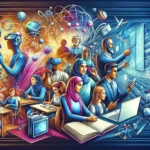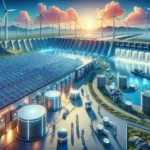In today's rapidly changing world, the lines between art and technology are increasingly becoming blurred. This fascinating intersection is not only transforming the way artists create but also how audiences engage with and appreciate art. Let’s dive into how this revolutionary convergence is reshaping the artistic landscape.
The Historical Context
Throughout history, technological advancements have influenced art. From the invention of the camera to digital media, each technological leap has brought new tools and techniques for artists to explore. The Renaissance period, for example, saw the development of linear perspective, thanks to advances in understanding geometry and optics.
The Renaissance
During the Renaissance, technology like the camera obscura allowed artists to achieve unprecedented levels of realism in their work. This period set the stage for future innovations and underscored the potential for technology to elevate artistic expression.
20th Century Innovations
The 20th century introduced mass media, computer graphics, and the internet, radically changing how art is produced, distributed, and consumed. These advancements democratized art, making it accessible to a global audience.
Digital Art: A New Frontier
In the digital age, the tools available to artists have multiplied exponentially. From graphic design software like Adobe Photoshop to 3D modeling programs like Blender, the possibilities are virtually limitless.
Graphic Design Software
Graphic design software has revolutionized the field of visual arts. Artists can now create complex designs with incredible precision, opening up new avenues for creativity.
3D Modeling
3D modeling tools allow artists to create intricate and lifelike three-dimensional objects, which can be used in everything from virtual reality experiences to video games and movies.
Digital Painting
Programs like Corel Painter and Procreate enable artists to paint digitally, mimicking the textures and strokes of traditional painting without the mess or material costs.
The Role of AI in Art
Artificial Intelligence (AI) is another groundbreaking technology reshaping the art world. AI programs can analyze massive datasets to generate new works of art or assist artists in the creative process.
AI-generated Art
Artificial Intelligence can create original pieces of art based on patterns and data. For instance, the artwork generated by the AI program ‘DeepDream’ has been showcased in galleries worldwide.
Assisting Artists
AI can also serve as a tool to aid human artists. Programs can suggest color schemes, composition adjustments, or even generate entire sketches based on input parameters.
The Impact on Traditional Art Forms
While technology is opening new doors, it is also influencing traditional art forms like painting, sculpture, and performance art.
Mixed Media
Artists are increasingly incorporating digital elements into traditional media, creating mixed-media works that blend the best of both worlds.
Interactive Installations
Performance and installation artists are leveraging technology to create immersive and interactive experiences. Virtual reality and augmented reality are particularly popular choices, offering audiences an opportunity to engage with the art on a deeper level.
Art in the Age of Social Media
Social media platforms like Instagram, TikTok, and Pinterest are changing how art is shared and appreciated. These platforms offer artists a global stage, increasing visibility and engagement.
Instagram has become a virtual gallery for artists, enabling them to share their work with a wider audience. The platform's visual nature is particularly suited to showcasing art, and many artists have found considerable success through it.
Short-form Video
Platforms like TikTok have popularized short-form video content. Artists are using these platforms to share behind-the-scenes looks at their creative processes, tutorials, and even to debut new works.
Art Communities
Online communities on platforms like Pinterest provide spaces where artists can share inspiration, techniques, and collaborate on projects.
The Future of Art and Technology
The intersection of art and technology holds endless possibilities. As advancements continue, the boundaries of what is possible in art will keep expanding.
Virtual and Augmented Reality
Virtual Reality (VR) and Augmented Reality (AR) technologies are set to revolutionize the art world further. These technologies allow for fully immersive experiences, where audiences can 'walk through' a painting or interact with a sculpture in a virtual environment.
Blockchain and NFTs
Blockchain technology and Non-Fungible Tokens (NFTs) are making waves in the art world by providing a new way to buy, sell, and authenticate art. This technology ensures transparency and authenticity, opening up new economic models for artists.
Conclusion
Art and technology, when combined, have the potential to create something truly extraordinary. Whether it's through digital tools, AI, or new platforms for sharing and experiencing art, the possibilities are endless. This dynamic intersection promises to keep pushing the boundaries of creative expression, challenging our perceptions, and enriching our lives in ways we are only beginning to understand.


